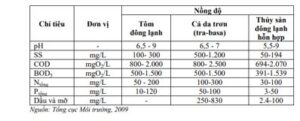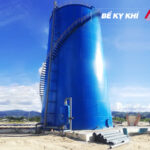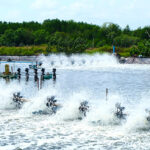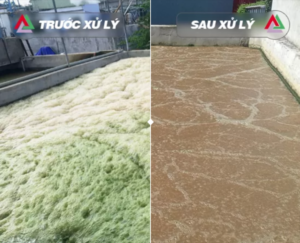Probiotics that treat nitrogen and ammonium are used in the treatment of aquatic wastewater to minimize the concentration of pollutants in wastewater. This process uses probiotics that can decompose nitrogen and ammonium into gas, helping to improve wastewater quality and protect the environment.
POLLUTION LEVEL OF AQUACULTURE WASTEWATER
Seafood processing is one of the key production industries of our country. Bringing great economic value, improving lives and income, creating jobs for people. However, seafood production and processing also pose major problems in aquatic wastewater treatment, especially nitrogen and ammonium treatment in wastewater.
Sources and impacts of aquatic wastewater
Aquatic wastewater is generated during the production and processing of raw materials, impregnating additives, pre-processing stages, boiling, steaming, cleaning tools, factories, etc. Seafood processing factories and enterprises products (white leg shrimp, tiger shrimp, pangasius, basa fish, sea fish, etc.) or canned food production, fresh food production often processes dozens of tons of seafood every day, creating a source of aquatic wastewater. Huge assets need to be handled.
Some specific impacts of aquatic wastewater on the environment
- Air pollution: Bad odors arise from raw materials and untreated waste after the production process, as well as decomposing waste in water. Organic waste that undergoes decomposition releases bad odors into the environment.
– Solid waste pollution: Solid waste generated during processing (shrimp shells, clam shells, fish bones and internal organs, etc.) needs to be treated.
– Wastewater pollution: Water is used in all stages of production to clean ingredients, tools, etc. and to process food. The water source after the production process contains many complex organic compounds, has a foul odor and cannot be used during the decomposition process.
Ingredients in aquatic wastewater
The pollution level of aquatic wastewater often depends on the scale and production method in factories. Aquatic wastewater may contain the following pollutants:
– High organic matter content in wastewater, rich in nutrients (carbohydrates, proteins, lipids,...)
– High COD, BOD, TSS content
– H2S, NH3 gas
– phosphates, nitrates, fats, detergents
– Disease-causing bacteria

Aquatic wastewater treatment process
1. Aquatic wastewater after processing and production will be mechanically treated to remove solid waste and suspended solid waste in the water.
2. Then, it is subjected to physical and chemical treatment to regulate pH levels suitable for the growth of microflora and optimize the decomposition of organic compounds in aerobic and anaerobic tanks.
3. At the end of the physicochemical process, the wastewater is circulated to the UASB anaerobic tank for treatment to reduce COD and BOD in the water.
4. Finally, it is treated in an aerobic tank to treat waste. Treat ammonium and nitrogen content in wastewater to standard thresholds.
In the process of treating aquatic wastewater, the most common problem is overloading ammonium and nitrogen targets. Because wastewater from the seafood industry contains many organic compounds that are difficult to treat, the concentration of nitrogen and ammonium in the water is high, making it difficult for the microorganism system to process it.
Benefits of using probiotics to treat nitrogen and ammonium in aquatic wastewater
Adding probiotics to treat nitrogen and ammonium in the aerobic tank will help limit the death of microorganisms and reduce load when the plant increases production. Overcoming the problem of sludge not settling in the aeration tank and causing green foam due to excessive and untreated nitrogen and ammonium concentrations in the wastewater. Reduce nitrogen, ammonium, BOD, COD, TSS in aquatic wastewater.
Probiotics for nitrogen and ammonium treatment contain specially isolated strains of microorganisms that specialize in removing total nitrogen, ammonium and odor-causing organic impurities from wastewater. Easily adapts to wastewater sources, accelerating the nitrification and denitrification reaction process. Improves nitrogen and ammonium concentrations in wastewater, helping to restore treatment systems.
In addition, probiotics also add many different types of microorganisms to speed up the decomposition of various organic compounds in aquatic wastewater. Limit the emission of bad odors in wastewater.
BUY MICROBIAL Yeast PRODUCTS THAT TREAT NITO AND AMONIUM – EnviClean AMO
Reasons why you should buy aerobic probiotics to treat Nitrogen and Ammonium - Enviclean Amo to treat ammonium concentration for rubber wastewater in aerobic tanks =>
Probiotics that process Nitrogen and Ammonium – EnviClean AMO is a product containing special microorganisms to remove total Nitrogen, Ammonium and odor-causing organic impurities from wastewater. This product combines strains of Bacillus, Nitrosomonas, Nitrobacter to create optimal activity and enzymes with higher efficiency in treating Ammonium and Nitrogen than other products on the market.
Probiotics that process Nitrogen and Ammonium – EnviClean AMO Easily adaptable in different environments and helps reduce odor and ammonia concentration in wastewater to acceptable levels.
Benefits of biological products for wastewater treatment - EnviClean AMO
1. Enhance the nitrification process in the aerobic tank and the denitrification process in the anoxic tank.
2. Improve and restore the system effectively.
3. Reduce ammonia odor in wastewater treatment system.
4. Reduce costs: operations and labor.
5. Reduce Nitrogen, Ammonium, BOD, COD, TSS
6. Overcome the phenomenon of dead and shocked microorganisms
7. Overcome the problem of foaming and sludge not settling in the aerobic tank
How to use probiotics to treat Nitrogen and Ammonium
Dosage is based on optimization level, pollutant load, waste source properties and different treatment facilities.
Standard dosage is as follows:
| Flow rate (m) | First month | 2nd month onwards |
|---|---|---|
| 0 – 10 m3 | 2 Pounds/Week | 1 Pound/Week |
| < 50 m3 | 4 Pounds/Week | 2 Pounds/Week |
| < 100 m3 | 6 Pounds/Week | 3 Pounds/Week |
| < 500 m3 | 8 Pounds/Week | 4 Pounds/Week |
| < 1000 m3 | 12 Pounds/Week | 6 Pounds/Week |
| < 3000 m3 | 20 Pounds/Week | 10 Pounds/Week |
Recommended: To achieve optimal results, you should add microorganisms to the water and aerate it for 24-36 hours before putting it into the system.
AN BINH ENVIRONMENTAL TECHNICAL TECHNOLOGY COMPANY LIMITED
🏠 Office address: 63/48 Street 9, Quarter 3, Truong Tho Ward, Thu Duc City, Ho Chi Minh City, Vietnam
☎️ Hotline: 0912.511.669.
🌎 Email: [email protected]
🌎 Fanpage: https://www.facebook.com/anbinh.eviclean









